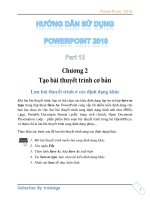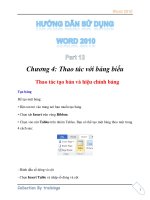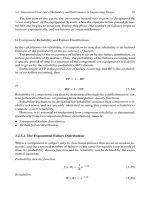Lubrication and Reliability Handbook 2010 Part 12 ppt
Bạn đang xem bản rút gọn của tài liệu. Xem và tải ngay bản đầy đủ của tài liệu tại đây (698.74 KB, 20 trang )
B20 Repair of worn surfaces
B20.8
Table 20.5 General guidance on the choice of process
B20Repair of worn surfaces
B20.9
Table 20.6 Available coating materials
B20 Repair of worn surfaces
B20.10
Table 20.6 (continued)
B20Repair of worn surfaces
B20.11
Table 20.6 (continued)
B20 Repair of worn surfaces
B20.12
Table 20.7 Factors affecting choice of coating material
B20Repair of worn surfaces
B20.13
Table 20.8 Methods of machining electroplated coatings
Table 20.9 Bearing materials compatible with electroplated coatings
When using deposited metals in sliding or rotating contact with other metals, adequate lubrication must be assured
at all times.
B20 Repair of worn surfaces
B20.14
Table 20.10 Examples of successful repairs
B21Wear resistant materials
B21.1
ABRASIVE WEAR
Abrasive wear is the loss of material from a surface that
results from the motion of a hard material across this
surface.
There are several types of abrasive wear. Since the
properties required of a wear-resistant material will
depend on the type of wear the material has to withstand,
a brief mention of these types of wear may be useful.
There are three main types of wear generally con-
sidered: gouging abrasion (impact), Figure 21.1; high-
stress abrasion (crushing), Figure 21.2; and low-stress
abrasion (sliding), Figure 21.3. This classification is
made more on the basis of operating stresses than on the
actual abrading action.
Gouging abrasion
This is wear that occurs when coarse material tears off
sizeable particles from wearing surfaces. This normally
involves high imposed stresses and is most often encoun-
tered when handling large lumps.
High-stress abrasion
This is encountered when two working surfaces rub
together to crush granular abrasive materials. Gross
loads may be low, while localised stresses are high.
Moderate metal toughness is required; medium abrasion
resistance is attainable.
Rubber now competes with metals as rod and ball mill
linings with some success. Main advantages claimed are
longer life at a given cost, with no reduction in
throughput, lower noise level, reduced driving power
consumption, less load on mill bearings and more
uniform wear on rods.
Low-stress abrasion
This occurs mainly where an abrasive material slides
freely over a surface, such as in chutes, bunkers, hoppers,
skip cars, or in erosive conditions. Toughness require-
ments are low, and the attainable abrasion resistance is
high.
Figure 21.1 Types of gouging abrasion
Figure 21.2 Types of high-stress abrasion: (a) rod
and ball mills; (b) roll crushing
Figure 21.3 Low-stress abrasion
B21 Wear resistant materials
B21.2
MATERIAL SELECTION
Very generally speaking the property required of a wear-
resistant material is the right combination of hardness
and toughness. Since these are often conflicting require-
ments, the selection of the best material will always be a
compromise. Apart from the two properties mentioned
above, there are few general properties. Usually the right
material for a given wear-resistant application can only be
selected after taking into consideration other factors that
determine the rate of wear. Of these the most important
are:
Ambient temperature, or temperature of material in
contact with the wear surface.
Size distribution of particles flowing over the wear
surface.
Abrasiveness of these particles.
Type of wear to which wear surface is subjected (i.e.
gouging, sliding, impact, etc.).
Velocity of flow of material in contact with wear
surface.
Moisture content or level of corrosive conditions.
General conditions (e.g. design of equipment, head-
room available, accessibility, acceptable periods of
non-availability of equipment).
Tables 21.1 and 21.2 give some general guidance on
material selection and methods of attaching replaceable
components.
Table 21.3 gives examples of actual wear rates of
various materials when handling abrasive materials.
The subsequent tables give more detailed information
on the various wear resistant materials.
Table 21.1 Suggested materials for various operating conditions
B21Wear resistant materials
B21.3
Table 21.2 Methods of attachment of replaceable wear-resistant components
B21 Wear resistant materials
B21.4
Table 21.3 Typical performance of some wear-resistant materials as a guide to selection
B21Wear resistant materials
B21.5
The following tables give more detailed information on the materials listed in Table 21.3 with examples of some typical
applications in which they have been used successfully.
When selecting the materials for other applications, it is important to identify the wear mechanism involved as this is
a major factor in the choice of an optimum material. Further guidance on this is given in Table 21.1.
Table 21.4 Cast irons
B21 Wear resistant materials
B21.6
Table 21.5 Cast steels
Table 21.6 Rolled steels
B21Wear resistant materials
B21.7
Table 21.7 Wear resistant coatings for steel
B21 Wear resistant materials
B21.8
Table 21.8 Some typical wear resistant hardfacing rods and electrodes
B21Wear resistant materials
B21.9
Table 21.9 Wear resistant non-metallic materials
B22 Repair of plain bearings
B22.1
In general, the repair of bearings by relining is confined
to the low melting-point whitemetals, as the high
pouring temperatures necessary with the copper or
aluminium based alloys may cause damage or distortion
of the bearing housing or insert liner. However, certain
specialist bearing manufacturers claim that relining with
high melting-point copper base alloys, such as lead
bronze, is practicable, and these claims merit investiga-
tion in appropriate cases.
For the relining and repair of whitemetal-lined bear-
ings three methods are available:
(1) Static or hand pouring.
(2) Centrifugal lining.
(3) Local repair by patching or spraying.
1 PREPARATION FOR RELINING
(a) Degrease surface with trichlorethylene or similar
solvent degreaser. If size permits, degrease in solvent
tank, otherwise swab contaminated surfaces
thoroughly.
(b) Melt off old whitemetal with blowpipe, or by
immersion in melting-off pot containing old white-
metal from previous bearings, if size permits.
(c) Burn out oil with blowpipe if surface heavily
contaminated even after above treatment.
(d) File or grind any portions of bearing surface which
remain contaminated or highly polished by move-
ment of broken whitemetal.
(e) Protect parts which are not to be lined by coating
with whitewash or washable distemper, and drying.
Plug bolt holes, water jacket apertures, etc., with
asbestos cement or similar filler, and dry.
2 TINNING
Use pure tin for tinning steel and cast iron surfaces; use
50% tin, 50% lead solder for tinning bronze, gunmetal
or brass surfaces.
Flux surfaces to be tinned by swabbing with ‘killed
spirit’ (saturated solution of zinc in concentrated com-
mercial hydrochloric acid, with addition of about 5%
free acid), or suitable proprietary flux.
Tinning cast iron presents particular difficulty due to
the presence of graphite and, in the case of used
bearings, absorption of oil. It may be necessary to burn
off the oil, scratch brush, and flux repeatedly, to tin
satisfactorily. Modern methods of manufacture embody-
ing molten salt bath treatment to eliminate surface
graphite enable good tinning to be achieved, and such
bearings may be retinned several times without
difficulty.
Tin bath
(i) Where size of bearing permits, a bath of pure tin
held at a temperature of 280°–300°C or of solder at
270°–300°C should be used.
(ii) Flux and skim surface of tinning metal and
immerse bearing only long enough to attain tem-
perature of bath. Prolonged immersion will impair
bond strength of lining and cause contamination of
bath, especially with copper base alloy housings or
shells.
(iii) Flux and skim surface of bath to remove dross, etc.,
before removing bearing.
(iv) Examine tinned bearing surface. Wire brush any
areas which have not tinned completely, reflux and
re-immerse.
Table 22.1 Guidance on choice of lining method
B22Repair of plain bearings
B22.2
Stick tinning
(i) If bearing is too large, or tin bath is not available,
the bearing or shell should be heated by blowpipes
or over a gas flame as uniformly as possible.
(ii) A stick of pure tin, or of 50/50 solder is dipped in
flux and applied to the surface to be lined. The tin
or solder should melt readily, but excessively high
shell or bearing temperatures should be avoided, as
this will cause oxidation and discoloration of the
tinned surfaces, and impairment of bond.
(iii) If any areas have not tinned completely, reheat
locally, rub areas with sal-ammoniac (ammonium
chloride) powder, reflux with killed spirit, and
retin.
3 LINING METHODS
(a) Static lining
(i) Direct lined bearings
The lining set-up depends upon the type of bearing.
Massive housings may have to be relined in situ, after
preheating and tinning as described in sections (1) and
(2). In some cases the actual journal is used as the
mandrel (see Figures 22.1 and 22.2).
Journal or mandrel should be given a coating of
graphite to prevent adhesion of the whitemetal, and
should be preheated before assembly.
Sealing is effected by asbestos cement or similar
sealing compounds.
(ii) Lined shells
The size and thickness of shell will determine the type of
lining fixture used. A typical fixture, comprising face
plate and mandrel, with clamps to hold shell, is shown in
Figure 22.5 while Figure 22.6 shows the pouring
operation.
Figure 22.1 Location of mandrel in end face of
direct lined housing
Figure 22.2 Outside register plate, and inside plate
machined to form radius
Figure 22.3 Direct lined housing. Pouring of
whitemetal
Figure 22.4 Direct lined housing, as lined
B22 Repair of plain bearings
B22.3
(b) Centrifugal lining
This method is to be preferred if size and shape of
bearing are suitable, and if economic quantities require
relining.
(i) Centrifugal lining equipment
For small bearings a lathe bed may be adapted if suitable
speed control is provided. For larger bearings, or if
production quantities merit, special machines with vari-
able speed control and cooling facilities, are built by
specialists in the manufacture or repair of bearings.
(ii) Speed and temperature control
Rotational speed and pouring temperature must be
related to bearing bore diameter, to minimise segrega-
tion and eliminate shrinkage porosity.
Rotational speed must be determined by experiment
on the actual equipment used. It should be sufficient to
prevent ‘raining’ (i.e. dropping) of the molten metal
during rotation, but not excessive, as this increases
segregation. Pouring temperatures are dealt with in a
subsequent section.
(iii) Cooling facilities
Water or air–water sprays must be provided to effect
directional cooling from the outside as soon as pouring
is complete.
(iv) Control of volume of metal poured
This is related to size of bearing, and may vary from a few
grams for small bearings to many kilograms for large
bearings.
The quantity of metal poured should be such that the
bore will clean up satisfactorily, without leaving dross or
surface porosity after final machining.
Excessively thick metal wastes fuel for melting, and
increases segregation.
(v) Advantages
Excellent bonding of whitemetal to shell or housing.
Freedom from porosity and dross.
Economy in quantity of metal poured.
Directional cooling.
Control of metal structure.
(vi) Precautions
High degree of metallurgical control of pouring tem-
peratures and shell temperatures required.
Close control of rotational speed essential to minimise
segregation.
Measurement or control of quantity of metal poured
necessary.
Control of timing and method of cooling important.
Figure 22.5 Lining fixture for relining of shell type
bearing
Figure 22.6 Pouring operation in relining of shell
type bearing
Figure 22.7 Purpose-build centrifugal lining
machine for large bearings
Figure 22.8 Assembling a stem tube bush 680 mm
bore by 2150 mm long into a centrifugal lining
machine
B22Repair of plain bearings
B22.4
4 POURING TEMPERATURES
(a) Objective
In general the minimum pouring temperature should be
not less than about 80°C above the liquidus temperature
of the whitemetal, i.e. that temperature at which the
whitemetal becomes completely molten, but small and
thin ‘as cast’ linings may require higher pouring tem-
peratures than thick linings in massive direct lined
housings or large and thick bearing shells.
The objective is to pour at the minimum temperature
consistent with adequate ‘feeding’ of the lining, in order
to minimise shrinkage porosity and segregation during
the long freezing range characteristic of many white-
metals. Table 22.2 gives the freezing range (liquidus and
solidus temperatures) and recommended minimum
pouring temperatures of a selection of typical tin-base
and lead-base whitemetals. However, the recommenda-
tions of manufacturers of proprietary brands of white-
metal should be followed.
(b) Pouring
The whitemetal heated to the recommended pouring
temperature in the whitemetal bath, should be thor-
oughly mixed by stirring, without undue agitation. The
surface should be fluxed and cleared of dross imme-
diately before ladling or tapping. Pouring should be
carried out as soon as possible after assembly of the
preheated shell and jig.
(c) Puddling
In the case of large statically lined bearings or housings,
puddling of the molten metal with an iron rod to assist
the escape of entrapped air, and to prevent the forma-
tion of contraction cavities, may be necessary. Puddling
must be carried out with great care, to avoid disturbance
of the structure of the freezing whitemetal. Freezing
should commence at the bottom and proceed gradually
upwards, and the progress of solidification may be felt by
the puddler. When freezing has nearly reached the top of
the assembly, fresh molten metal should be added to
compensate for thermal contraction during solidifica-
tion, and any leakage which may have occurred from the
assembly.
(d) Cooling
Careful cooling from the back and bottom of the shell or
housing, by means of air–water spray or the application
of damp cloths, promotes directional solidification,
minimises shrinkage porosity, and improves adhesion.
5 BOND TESTING
The quality of the bond between lining and shell or
housing is of paramount importance in bearing perform-
ance. Non destructive methods of bond testing
include:
(a) Ringing test
This is particularly applicable to insert or shell bearings.
The shell is struck by a small hammer and should give a
clear ringing sound if the adhesion of the lining is good.
A ‘cracked’ note indicates poor bonding.
(b) Oil test
The bearing is immersed in oil, and on removal is wiped
clean. The lining is then pressed by hand on to the shell
or housing adjacent to the joint faces or split of the
bearing. If oil exudes from the bond line, the bonding is
imperfect.
Table 22.2 Whitemetals, solidification range and pouring temperatures









